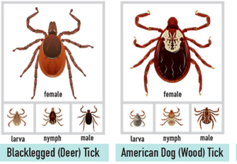
May is Lyme Disease Awareness Month and the perfect opportunity to update your schools’ tick IPM program. Tick IPM is all about Prevention, Tick ID and Monitoring, Effective Tick Control measures when needed, and Record-Keeping. Here are some tips:
Image credit: New York State IPM Program
Prevention
Discourage Rodents: Small rodents are part of the tick-borne disease cycle. Ticks acquire Lyme and diseases from mice and other small rodents. Keep foundations in good repair. Seal off holes in and under buildings and sheds. Seal gaps in rock walls. Mow, bush-hog, weed-whack and prune to eliminate grassy, brushy, and shrubby areas that harbor rodents. Do not allow stacks of materials (such as unused equipment, lumber, brush piles) to sit on the ground. Remove or raise them well off the ground to eliminate potential rodent harborage. Discontinue feeding birds in spring and summer. Clean up dropped seed under feeders.
Keep People Away from Ticks: Move swing sets and sand boxes away from the woodland edge. Use signage and barriers to keep people away from tick-infested areas. Clear and widen woodland trails.
Emphasize Personal Protection: Educate staff and families about proper personal protection such as applying repellent to exposed skin, wearing light-colored long sleeves and long pants, and performing regular tick checks. Repellents containing picaridin or at least 20% DEET are most effective. For grounds crew, permethrin-treated clothing and gaiters may be helpful in reducing the risk of tick bites. Print and hang this poster to remind and instruct how to perform tick checks. See US CDC or Maine CDC for more guidance on personal protection. Downloadable posters, wallet cards and other educational materials are available (see links below). Visit the Maine CDC website for an excellent educational resource for classroom use.
Tick Identification and Monitoring
Black-legged Tick thrives in moist, shady spots primarily in and within about 10 feet of wooded areas and shaded garden beds where leaf litter or low-growing plants provide ideal tick habitat. The black-legged tick is by far the most concerning as it carries the microbes that cause Lyme disease, Powassan fever and other human illnesses.
American Dog Tick tolerates drier habitats and can be found in open sunny areas among tall grass or sometimes in the moist wood chips under a swing-sets, especially if unmown grass is nearby. Though often quite abundant in spring, this tick rarely transmits diseases in Maine.
To effectively manage ticks and protect your students and staff, it is important to identify and monitor for ticks to learn which tick species are active, where, and when. Monitoring also tells you whether your interventions were effective.
Passive Monitoring: Work with teachers, school nurse, and others to teach students and staff how to perform body checks for ticks after being outdoors. Create a ‘tick encounter’ reporting system to track where, when and what kind of tick are encountered on school grounds. A simple poster-mounted map of the school grounds can be used by students and teachers to mark where ticks are found. One school tapes actual ticks removed from clothing or skin to the poster as a visual record-keeping system!
Active Monitoring: Professionals use a relatively simple method called ‘tick dragging’ that you can try yourself. Attach a 3’x3’ square of sturdy, light-colored flannel or corduroy cloth to a wooden dowel. Tie twine to the dowel for a handle. Drag the cloth over the ground and low vegetation on sunny, dry days. Walk about 100 feet, then inspect the bottom side of the cloth for ticks. Keep a record to document the number of each species and dates of ticks collected at each location. Be sure to use personal protective measures (repellent, protective clothing, thorough body check for ticks). Here is a short how-to video on tick dragging.
Tick Suppression with Pesticides
If landscaping modifications and personal protection measures are insufficient, a well-timed, ‘barrier’ pesticide application by a licensed professional may be considered. Pesticides should only be applied to known black-legged tick habitat— at the interface where open play areas meet up with brushy/wooded areas. It is standard to treat 20 feet into the brushy/wooded areas and 10 feet into the open space at the margin. Shady wooded trails and areas of low-growing ornamental plant cover (such as pachysandra) may also be treated. It is not helpful or effective to treat lawns and open sunny areas.
One application in late spring (mid-May to mid-June in Maine) is most effective, with a second application in mid to late October if needed. Avoid monthly applications marketed as ‘tick and mosquito’ treatments. Pesticide products containing permethrin or bifenthrin work well against ticks. Companies offering tick control services in Maine.
Requirements: Pesticides can only be applied on school properties by a properly licensed applicator. Don’t forget to post signs at entrance to areas to be treated 2 days before treatment. For applications made during the school year (when schools re-open!) notify parents and staff 5 working days in advance. Download forms for notification and signs. All pesticide regulations apply to all pesticides including organic and natural products. Research to develop alternative control strategies such as biopesticides and host-targeted treatments (such as mouse-bait boxes intended to kill or treat ticks on mice) are ongoing.
Learn More
Resources
|